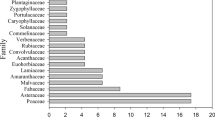Abstract
During surveys conducted in 40 maize-cassava intercrops in the humid forest zone of southwestern Nigeria, the following termite species were identified from soil samples: Microtermes spp., Macrotermes nigeriensis (Sjöstedt), Macrotermes subhyalinus (Rambur), Amitermes evuncifer (Silvestri) and Anoplotermes quietus (Fr. Muller). High incidence of Microtermes and Macrotermes spp. was observed. The population density of predominant species was generally higher in the rainy seasons than in the dry seasons, indicating the role of moisture in their spread. The soil texture of surveyed farms did not influence the presence of the subterranean species Microtermes. The level of weeds in the surveyed farms also did not affect the population density of termites. However, Microtermes population increased significantly (P < 0.05) with increase in crop residues and its presence in farms partly depended on the presence of maize in such farms. Microtermes and Macrotermes species inflicted most of the damage observed on maize crops, while that caused by Amitermes evuncifer waslow. No termite attack was observed on growing cassava during the surveys. The presence of live cassava in the intercrop did not influence damage by termites. Nasutitermes and Microcerotermes species which attack economic trees such as cocoa, citrus, oil palm, and forest trees did not attack cassava or maize.
Résumé
Les échantillonnages effectués sur 40 champs de maïs associés au manioc dans la zone agroécologique de la forêt humide dans le sud-oeust du Nigeria indiquaient la présence des espèces de termites suivantes sur les prélèvements du sol: Microtermes spp., Macrotermes nigeriensis (Sjöstedt), Macrotermes subhyalinus (Rambur), Amitermes evuncifer (Silvestri) et Anoplotermes quietus (F. Muller), Une haute présence des espèces de Microtermes et Macrotermes a été constatée. La présence ainsi que la population des espèces prédominantes étaient généralement plus hautes pendant la saison pluvieuse que pendant la saison sèche, indiquant le role de l’humidité sur leur propagation. Les textures du sol des champs échantillonnés n’avaient pas d’effets significatifs aux présences des espèces souterraines, Microtermes. Les niveaux de mauvaises herbes dans les champs échantillonés n’avaient pas aussi d’effet sur la densité des termites. Néanmoins, la population de Microtermes augmentait significativement (P < 0, 05) selon la quantité de résidue des plantes restant aux champs, et leur présence dans les champs dépandait de la présence du maïs. Les espèces de Microtermes et Macrotermes infligaient les pluparts des dégâts observés sur les cultures de maïs. Les dégâts causés par Amitermes evuncifer au maïs étaient faibles. Aucune attaque par les termites n’a été constatée sur les cultures du manioc pendant les échantillonnages. Les espèces de Nasutitermes et Microcerotermes qui ont attaqués les arbres économiques comme les cacaos, les agrumes, les palmiers à huile et les arbres forestiers n’ont pas attaqués le manioc ni le maïs.
Similar content being viewed by others
References
Abbas H. M. and Ahmed F. U. (1984) Insect pests of pulses in Pakistan, pp. 184–207. In Insect Pests of Important Crops in Pakistan (Edited by F. U. Ahmed). Pakistan Ministry of Food, Agriculture and Cooperatives, Karachi.
Darlington J. P. E. C. (1985) Multiple primary reproductives in the termite Macrotermes michaelseni (Sjöstedt.), pp. 187–200. In Caste Differentiation in Social Insects (Edited by J. A. L. Watson, B. M. Okot-Kotber and C. Noirot). Oxford, Pergamon Press.
Lee K. E. and Wood T. G. (1971) Termite and Soils. Acad. Press. London and New York. 251 pp.
Onwueme I. C. (1978) The Tropical Tuber Crops. English Language Book Society and John Wiley & Sons, Chichester, pp. 142–144.
Parry M. S. (1959) Control of termites in Eucalyptus plantations. Empire Forestry Review 38, 287–292.
Reddy M. V. and Sammaiah C. (1988) Odontotermes brunneus (Hagen) (Termitidae: Isoptera) as a new-pest of maize and groundnut. Entomon. 13, 47–50.
Ripper E. E. and George L. (1965) Cotton Pests of the Soudan. Blackwell, Oxford. 345 pp.
Sands W. A. (1962) Observations on termites destructive of trees and crops in Nigeria. North. Reg. Min. Agric. Samaru Res. Bull. 26, 1–14.
SAS Institute (1985) SAS Users’ Guide: Statistics. 5th Ed. SAS Inst., Cary, North Carolina.
Sieber R. (1985) Replacement of reproductives in Macrotermitinae (Isoptera, Termitidae), pp. 201–207. In Caste Differentiation in Social Insects (Edited by J. A. L. Watson, B. M. Okot-Kotber and C. Noirot). Pergamon Press, Oxford.
Silvapalan P., Karunaratne A. A. G and Jayatilleke D. S. G. (1980) Clonal susceptibility and the influence of shade trees on the incidence of Glyptotermes dilatatus (Bugnion and Popoff) (Isoptera: Kalotermitidae) in tea. Bull. Entomol. Res. 70, 145–149.
Smyth A. J. and Montgomery R. F. (1962) Soils and Land-Use in Central Western Nigeria, Ibadan. Govt, of Western Nigeria, Ministry of Agriculture and Natural Resources.
Srivastava K. P. and Butani D. K. (1987) Insect pests of tea in India and their control. Pesticides 21, 16–21.
Wardell D. A. (1987) Control of termites in nursery and young plantations in Africa: Established practices and alternative courses of action. Commonwealth Forestry Review 66, 77–79.
Wilkinson H. (1940) Termites in East Africa. II. The biology and control of termites damaging grassland. East African Agricultural Journal 6, 67–72.
Wood T. G. and Johnson R. A. (1978) Abundance and vertical distribution in soil of Microtermes (Isoptera: Termitidae) in savanna woodland and agricultural ecosystems of Mokwa, Nigeria. Memorabilia Zoologica 29, 203–213.
Wood T. G., Johnson R. A, and Ohiagu C. E. (1980) Termite damage and crop loss studies in Nigeria—A review of termite damage to maize and estimation of damage, loss of yield and Microtermes abundance at Mokwa. Trop. Pest Manage. 26, 241–253.
Author information
Authors and Affiliations
Corresponding author
Additional information
See Editor’s Note at the end of this issue.
Rights and permissions
About this article
Cite this article
Umeh, V.C., Ivbijaro, M.F. Termite Abundance and Damage in Traditional Maize-Cassava Intercrops in Southwestern Nigeria. Int J Trop Insect Sci 17, 315–321 (1997). https://doi.org/10.1017/S1742758400019123
Accepted:
Published:
Issue Date:
DOI: https://doi.org/10.1017/S1742758400019123




